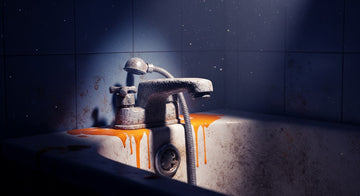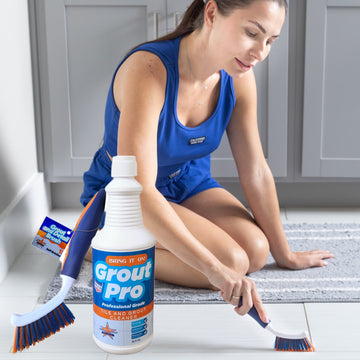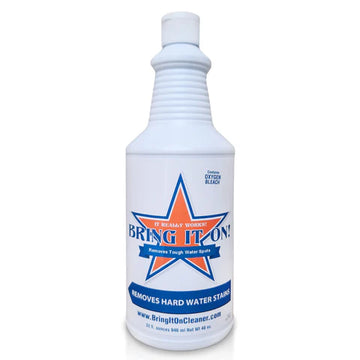Imagine spending hours scrubbing your home appliances, ranging from shower doors to kitchen sinks, only to encounter stubborn hard water spots that seem unyieldable. The secret to melting away these tenacious foes lies in the pH scale. Unleash a world of efficient cleaning by deciphering the science behind pH and its impact on cleansing power. With this knowledge at your fingertips, you will be equipped to wage an effective cleaning battle against even the most obstinate hard water spots! Dive into our latest blog post to discover more about how you can harness the power of pH in your cleaning routine.
The pH level of a cleaning product can significantly impact its cleaning power. Acidic cleaners work best for soils resulting from mineral deposits, such as hard water exposure, while alkaline cleaners are more effective for hydrolyzing soils like kitchen grease. It is important to select the appropriate pH level for each cleaning task to achieve optimal results and avoid damaging surfaces or fibers.
Understanding pH and Its Role in Cleaning
To truly unlock the cleaning power of pH, it's crucial to first understand what pH is and how it affects the cleaning process. pH, or potential of hydrogen, is a measurement of acidity or alkalinity on a scale from 0 to 14. A pH of 7 is considered neutral, while values below 7 indicate acidity and values above 7 indicate alkalinity. In the world of cleaning, this scale plays a significant role in determining the effectiveness of different cleaning agents for specific tasks.
When it comes to cleaning, different surfaces and types of dirt require different pH levels for optimal results. For example, alkaline cleaners with higher pH levels are effective at removing oily or greasy soils. They work by breaking down the chemical bonds in fats and proteins, making them easier to remove. On the other hand, acidic cleaners with lower pH levels are ideal for tackling mineral deposits like hard water stains or removing soap scum. They work by dissolving these minerals and breaking up soap residue.
Understanding the pH level needed for a particular cleaning task is essential because it directly impacts the effectiveness of the cleaning agent. Using a cleaner with an incorrect pH can result in inefficient cleaning or even damage to surfaces.
Let's consider an example: You have stubborn grease stains on your kitchen countertops. Since grease is best dissolved by alkaline solutions, using an alkaline cleaner with a higher pH will help break down the grease more effectively than an acidic cleaner. The higher pH creates an environment where grease molecules can be easily lifted off the surface.

Moreover, knowing the appropriate pH level for cleaning also helps protect delicate surfaces. Some materials, like marble or certain metals, are sensitive to acidic or alkaline substances. Using a cleaner with the wrong pH can lead to etching or discoloration, causing irreversible damage.
Now that we have a solid understanding of what pH is and its role in cleaning, let's explore the relationship between pH and cleaning efficiency.
The Relationship Between pH and Cleaning Efficiency
The pH level of a cleaning agent directly influences its ability to remove specific types of dirt or stains effectively. As mentioned earlier, alkaline solutions with higher pH levels excel at breaking down greasy soils, while acidic solutions with lower pH levels are best suited for tackling mineral deposits.
Consider a scenario where you need to clean a toilet bowl stained with hard water deposits. An acidic cleaner with a lower pH will work wonders in dissolving these mineral-based stains, as it can effectively break up the chemical bonds holding them to the surface.
However, it's important to note that extreme pH levels (very high or very low) can also have negative effects on cleaning efficiency. Too high of a pH can damage surfaces, strip away finishes, or leave residues behind. Conversely, extremely low pH levels can corrode metals or cause harm to skin and respiratory systems.

Determining the ideal pH for a cleaning task often involves a balance between effectiveness and safety. Mild acids or alkaline solutions within an appropriate pH range tend to be most effective for general cleaning purposes without causing damage.
Think of the relationship between pH and cleaning efficiency like cooking: getting the right combination of spices enhances the flavors of a dish, while adding too much or too little can ruin it. The same principle applies to cleaning - finding the right balance in pH ensures maximum effectiveness without compromising safety.
By understanding the relationship between pH and cleaning efficiency, you can make informed decisions when selecting cleaners for different tasks. Assessing the nature of the dirt or stain and choosing the appropriate pH level will ultimately lead to more successful and efficient cleaning outcomes.
- Understanding the role of pH levels in cleaning agents is essential for successful and efficient cleaning. The pH level directly affects a cleaner's ability to remove specific types of dirt or stains effectively, and extreme pH levels can have negative effects on cleaning performance and safety. Finding the right balance in pH ensures maximum effectiveness without compromising safety, similar to cooking with the right combination of spices. Therefore, assessing the nature of the dirt or stain and choosing the appropriate pH level will lead to more successful and efficient cleaning outcomes.
Comparing Natural and Synthetic pH-Determined Cleaners
When it comes to choosing cleaning products, understanding the difference between natural and synthetic pH-determined cleaners is crucial. Natural cleaners often boast a reputation for being eco-friendly, while synthetic cleaners are known for their powerful cleaning capabilities. However, there are important factors to consider before making a decision. For example, if you are looking for a hard water stain remover that can effectively remove mineral deposits, soap scum, and rust from various surfaces, you might want to try Bring It On Cleaner hard water spot remover. Bring It On Cleaner is a unique product that uses oxygen bleach to safely and gently clean without harming the environment.
Natural pH-determined cleaners are typically derived from plant-based ingredients or naturally occurring substances. They are known for their biodegradability and minimal impact on the environment. These cleaners often have a pH level in the neutral to slightly alkaline range, making them safe for various surfaces and materials. Some examples of natural pH-determined cleaners include vinegar, lemon juice, baking soda, and castile soap.
On the other hand, synthetic pH-determined cleaners are formulated with chemical compounds specifically designed to tackle tough stains and dirt. These cleaners can have a pH level that ranges from highly acidic to highly alkaline, depending on the target cleaning task. For instance, acidic cleaners are effective at removing mineral deposits like limescale, while alkaline cleaners excel at removing greasy residues. Synthetic cleaners may contain surfactants, enzymes, and other additives to enhance their cleaning power.
Let's say you encounter a stubborn grease stain on your kitchen countertop. A natural pH-determined cleaner like lemon juice or vinegar might not be as effective in breaking down the grease as a synthetic alkaline cleaner would be. In this case, the synthetic cleaner's higher alkalinity can cut through the grease more efficiently.
However, it's important to note that both natural and synthetic pH-determined cleaners have their advantages and disadvantages. Natural cleaners offer a greener alternative with less harm to the environment, but they may have limitations in terms of tackling heavy-duty cleaning tasks. Synthetic cleaners, on the other hand, excel at removing stubborn stains but may come with potential environmental concerns due to their chemical composition.
Now that we understand the differences between natural and synthetic pH-determined cleaners, let's explore the topic of ingredient analysis and how it can help us determine the effectiveness and safety of these cleaning products.
Ingredients Analysis: The Good, the Bad, and the Alkaline
When it comes to determining which cleaning products to use, analyzing the ingredients is an essential step. This analysis helps identify what makes a cleaner effective, safe, and suitable for specific cleaning tasks. Let's take a closer look at some key factors in ingredients analysis: the good, the bad, and the alkaline.
The "good" ingredients typically include natural or biodegradable substances that are safe for humans and the environment. These ingredients often come from renewable resources and have minimal impact when released into water systems. Examples of good ingredients include plant-based surfactants derived from coconut oil or citric acid from fruits like lemons. These ingredients provide effective cleaning power while minimizing potential health hazards.
Conversely, "bad" ingredients tend to be harsh chemicals that can pose risks to human health or the environment. These may include petroleum-based solvents or synthetic fragrances that can trigger allergies or respiratory issues. It's important to carefully review product labels and avoid cleaners containing harmful substances such as chlorine bleach, ammonia, or phthalates.
Now let's talk about "alkaline" ingredients. Many strong cleaning agents fall on the alkaline side of the pH scale due to their ability to break down greasy residues and remove tough stains. However, high alkalinity can also cause damage if used improperly or on sensitive surfaces. It's crucial to follow instructions provided by manufacturers to ensure safe usage of alkaline-based cleaners.
Some might argue that using strong alkaline cleaners with high pH levels is unnecessary and can lead to environmental damage or harm delicate surfaces. Others contend that alkaline cleaners are essential for certain cleaning tasks and can be used safely with proper care and dilution. The debate persists, and finding a balance between effective cleaning and minimizing risks is key.
Having considered the importance of ingredient analysis, we will now shift our focus to the environmental impact of pH-based cleaners.
Environmental Impact of pH-Based Cleaners
When it comes to cleaning products, understanding the environmental impact of pH-based cleaners is crucial. The pH level determines the acidity or alkalinity of a cleaner and significantly influences its effectiveness and potential harm to the environment.
High-pH cleaners, often seen in traditional household cleaning products, tend to be more alkaline. While these cleaners can effectively break down grease and grime, they can also have negative consequences. The high alkalinity can be harmful if not properly diluted or rinsed away after use, as it may negatively affect aquatic life when it enters our waterways through drains. Alkaline cleaners are known to contribute to nutrient-loading and smog formation, impacting both our ecosystems and air quality.

On the other hand, low-pH cleaners, usually with a higher acidity level, offer a greener alternative that minimizes these environmental risks. These cleaners are less likely to contribute to water pollution and nutrient-loading when used as directed since they require milder dilutions and don't leave behind harmful residue. By opting for lower pH cleaners, we can make proactive choices that align with sustainable cleaning practices.
Understanding the environmental impact of pH-based cleaners lays the foundation for making green choices. Let's now explore the benefits of choosing lower pH cleaners for our cleaning needs.
Making Green Choices: The Benefits of Lower pH Cleaners
Choosing lower pH cleaners not only helps reduce environmental harm but also offers a range of benefits for both indoor and outdoor cleaning tasks. Lower pH cleaners are generally formulated to be more neutral or slightly acidic, which provides several advantages.
One significant benefit is their reduced toxicity compared to high-pH alternatives. Lower pH formulations are often gentler on surfaces while still effectively removing dirt, stains, and grime. This characteristic makes them an ideal choice for delicate materials like fabrics, carpets, or painted surfaces that may be sensitive to harsh alkaline substances.
Consider a scenario where you need to clean a delicate silk rug stained with red wine. Using a high-pH cleaner might pose a risk of discoloration or damage to the fabric fibers. However, opting for a lower pH cleaner designed specifically for delicate materials can ensure effective stain removal without compromising the integrity of the rug.
Some argue that higher pH cleaners are more powerful and provide better cleaning results. While it's true that high-pH cleaners can break down tough stains and grease effectively, the key is to strike a balance between cleaning power and environmental impact. By using lower pH cleaners in appropriate concentrations and following manufacturer guidelines, we can achieve excellent cleaning outcomes while minimizing harm to both the environment and our surfaces.
In addition to being gentle and effective, lower pH cleaners also offer another advantage: improved indoor air quality.
Many traditional cleaning products with high pH levels can release volatile organic compounds (VOCs) into the air, affecting indoor air quality and potentially leading to respiratory issues. By choosing lower pH cleaners, we can significantly reduce VOC emissions and create a healthier home environment for ourselves and our loved ones.
Optimum Cleaner Selection: A pH Guide for Surfaces and Materials
Selecting the right cleaner for specific surfaces and materials is crucial to achieving effective cleaning results. The pH level of a cleaner plays a significant role in determining its cleaning power and compatibility with different surfaces. Understanding how pH affects the cleaning process is essential in making informed choices when it comes to selecting the optimum cleaner. For instance, if you are looking for a cleaner that can effectively remove hard water stains from glass, tile, porcelain, and metal surfaces, you might want to consider Bring It On Cleaner hard water spot remover. Bring It On Cleaner hard water spot remover is a pH-neutral cleaner that uses oxygen bleach to safely and gently clean without damaging the surface or leaving behind residues.
pH is a measure of acidity or alkalinity, and it ranges from 0 to 14. A pH value below 7 indicates acidity, while values above 7 indicate alkalinity. Different surfaces and materials have varying levels of sensitivity to pH, making it important to match the appropriate cleaner pH with the specific surface being cleaned.
For example, acidic cleaners with a lower pH are generally more effective at removing mineral deposits, rust stains, and soap scum from bathroom fixtures. These types of cleaners can be used on surfaces such as porcelain or ceramic tiles without causing damage.
On the other hand, alkaline cleaners with a higher pH are ideal for breaking down grease, oils, and organic matter. They are commonly used on kitchen surfaces like countertops and stovetops. However, it's important to note that high alkaline cleaners may not be suitable for delicate materials like marble or natural stone, as they can cause etching or discoloration.
To provide a clearer understanding, let's take a look at how different pH levels correspond to common cleaning tasks:
|
PH Level |
Cleaning Task |
|
<4 |
Removing mineral deposits |
|
5-6 |
Removing soap scum |
|
7 |
Neutral pH (water) |
|
8-10 |
Degreasing |
|
>10 |
Removing heavy grease or oils |
Keep in mind that these are general guidelines, and it's always crucial to consider the specific instructions provided by the manufacturer of both the cleaner and the surface being cleaned.
Each cleaner has a specific pH level stated on its label or product information. It's important to refer to this information and choose a cleaner with a pH suitable for the surface you intend to clean. Matching the pH of the cleaner to the pH sensitivity of the surface helps ensure effective cleaning while minimizing any potential damage.
For instance, if you have delicate wooden floors, selecting a neutral pH cleaner specifically formulated for wood is recommended. This avoids using cleaners that may be too acidic or alkaline and potentially strip away natural oils or cause discoloration.
Additionally, when considering cleaner selection, it's essential to understand that some surfaces can tolerate a wider pH range than others. For example, glass is generally less sensitive to pH variations compared to other surfaces like fabric or leather upholstery.
However, there may be instances where multiple surface types are present in an area. In such cases, finding a compromise between cleaners suitable for each material can be challenging. One option is to prioritize using cleaners with neutral pH levels that are less likely to cause harm across various surfaces while still providing effective cleaning results.
Think of it as harmonizing different ingredients in a recipe - you want them to work together without overpowering or diminishing each other's flavors.
So when it comes to optimum cleaner selection based on pH guide for surfaces and materials, remember:
- Acidity works well for removing mineral deposits and soap scum.
- Alkalinity is effective at breaking down grease and organic matter.
- Different surfaces have varying pH sensitivities.
- Always refer to manufacturer instructions and labels for specific cleaner recommendations.
- Consider neutral pH cleaners if dealing with multiple surface types.
By understanding how pH affects cleaning power and selecting cleaners accordingly, you can unlock the full potential of your cleaning efforts and ensure optimal results on different surfaces without causing unnecessary damage.





